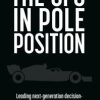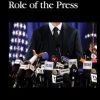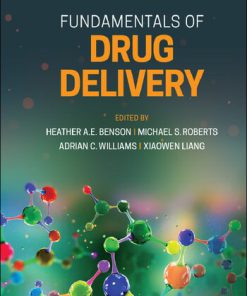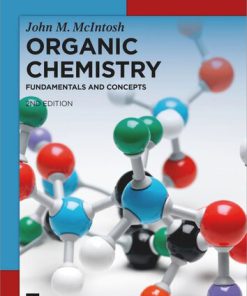Fundamentals of Medicinal Chemistry and Drug Metabolism 1st Edition by M O Faruk Khan, Ashok E Philip ISBN 9781681086873 1681086875
$50.00 Original price was: $50.00.$25.00Current price is: $25.00.
Fundamentals of Medicinal Chemistry and Drug Metabolism 1st Edition by M O Faruk Khan, Ashok E Philip – Ebook PDF Instant Download/Delivery: 9781681086873 ,1681086875
Full download Fundamentals of Medicinal Chemistry and Drug Metabolism 1st Edition after payment

Product details:
ISBN 10: 1681086875
ISBN 13: 9781681086873
Author: M O Faruk Khan, Ashok E Philip
Fundamentals of Medicinal Chemistry and Drug Metabolism 1st Edition Table of contents:
- Drugs Affecting Renin-Angiotensin System
- M. O. Faruk Khan1,* and Karrie Murphy1
- HISTORICAL BACKGROUND
- INTRODUCTORY CONCEPTS
- The Renin-Angiotensin System (RAS)
- Angiotensin-Converting Enzyme Inhibitors (ACEIs)
- Structure of ACE Active Site and Mechanism of Ang I Hydrolysis
- Inhibition of ACE – The ACEI-ACE Interaction
- Pharmacophore and SAR Summary of ACEIs
- SAR Summary
- The Individual ACEIs and their Structural and Therapeutic Evaluations
- Sulfhydryl-Containing Inhibitor – Captopril
- Dicarboxylate Containing Inhibitors
- Phosphinate Containing Inhibitor – Fosinopril
- ANGIOTENSIN II RECEPTOR BLOCKERS (ARBS)
- The AT1R Binding Pockets
- Pharmacophore of ARBs and Structure-Activity Relationship
- SAR Summary
- The Individual ARBs and their Structural and Therapeutic Evaluations
- Recalls of the ARBs
- Therapeutic Considerations of ACEI and ARBs
- RENIN INHIBITOR ALISKIREN (TEKTURNA®)
- CASE STUDY
- DRUG DISCOVERY CASE STUDIES
- Discovery of ACEIs
- Teprotide-the First Clue
- Carboxypeptidase A – the Homology Model
- Development of Captopril
- Development of Enalapril and Lisinopril
- Development of ARBs
- From Saralasin to Losartan and Eprosartan
- STUDENT SELF-STUDY GUIDE
- STUDENT SELF-ASSESSMENT QUESTIONS
- REFERENCES
- Ca+2 Channel Blockers
- Taufiq Rahman1 and M. O. Faruk Khan2,*
- HISTORICAL BACKGROUNDS OF CA2+-CHANNEL BLOCKERS
- INTRODUCTORY CONCEPTS
- The Voltage Gated Ca2+-Channels (VGCCs) and their Clinical Significance
- Sub-classes of VGCC
- CALCIUM CHANNEL BLOCKERS
- The 1,4-Dihydropyridines (DHPs)
- Structure Activity Relationship (SAR) of DHP Derivatives
- NO-Releasing Activity of 1,4-Dihydropyridines
- Individual 1,4-Dihydropyridine Drugs
- Phenylalkylamines (PAAs)
- Structure-Activity Relationship of the Phenylalkylamines
- Verapamil
- Benzothiazepines (BTZs)
- Structure-Activity Relationships of Benzothiazepines
- Diltiazem
- Diaminopropanol Ethers
- CLINICAL CASE STUDIES
- Case 1
- Case 2
- Case 3
- DRUG DISCOVERY CASE STUDIES
- Discovery of Verapamil
- Discovery of Nifedipine and its Analogues
- STUDENT SELF-STUDY GUIDE
- STUDENT SELF-STUDY QUESTIONS
- Part I: Multiple Choice Questions.
- Questions 6 – 8 are Based on the Following Structures:
- REFERENCES
- Diuretics
- David J. Weldon1, Krista G. Brooks2 and M. O. Faruk Khan3,*
- HISTORICAL PERSPECTIVES
- INTRODUCTORY CONCEPTS
- OSMOTIC DIURETICS
- Mechanism of Action of the Osmotic Diuretics
- Available Therapeutic Agents (Table 2)
- CARBONIC ANHYDRASE INHIBITORS
- Mechanism of Action of CAIs
- SAR Summary of Sulfonamides as CAIs
- Available Therapeutic Agents (Tables 3 and 4)
- THIAZIDE DIURETICS
- Mechanism of Action of Thiazide Diuretics
- SAR Summary of Thiazide Diuretics
- Available Therapeutic Agents (Table 5)
- LOOP DIURETICS
- Mechanism of Action of Loop Diuretics
- SAR Summary of Loop Diuretics
- Available Therapeutic Agents
- POTASSIUM-SPARING DIURETICS
- Aldosterone Antagonists
- Available Agents
- Non-Steroidal MRA: Finerenone (Kerendia®)
- Epithelial Sodium Channel (ENaC) Antagonists
- Available Agents (Table 8)
- CASE STUDIES
- Case 1
- Case 2
- Case 3
- DRUG DISCOVERY CASE STORIES
- Discovery of Carbonic Anhydrase Inhibitor: Acetazolamide
- Discovery of the Thiazide Diuretic Chlorothiazide
- Discovery of Loop Diuretic Furosemide
- STUDENT SELF-STUDY GUIDE
- STUDENT SELF-ASSESSMENT QUESTIONS
- REFERENCES
- Anticoagulants, Antiplatelets and Thrombolytic Agents
- M. O. Faruk Khan1,* and A. R. M. Ruhul Amin2
- HISTORICAL BACKGROUND
- INTRODUCTORY CONCEPTS
- Hemostasis
- Biochemical Pathway of Clotting
- Blood Coagulation Risk Factors
- ANTICOAGULANTS
- Heparin and Derivatives
- UFHs and LMWHs
- Mechanism of Action
- Adverse Effects, Contraindications, Antidotes and Pharmacokinetics
- Fondaparinux (Arixtra®)
- Warfarin
- Chemistry, Mechanism of Action, and Therapeutic Uses
- Pharmacokinetics
- Monitoring of Warfarin Therapy
- Food and Drug Interactions
- DIRECT THROMBIN INHIBITORS (DTIS)
- Hirudin and its Recombinant Derivatives
- Argatroban
- Oral Direct Thrombin Inhibitor: Dabigatran
- DIRECT FACTOR XA INHIBITORS
- Rivaroxaban (Xarelto®)
- Apixaban (Eliquis®)
- Edoxaban (Savaysa®)
- Betrixaban (Bevyxxa®)
- ANTIPLATELET AGENTS
- Cyclooxygenase Inhibitor: Aspirin
- Glycoprotein IIb/IIIa Receptor Blockers
- Abciximab (ReoPro®)
- Eptifibatide (Integrilin®)
- Tirofiban (Aggrastat®)
- P2Y12 Receptor Blockers: Clopidogrel, Ticlopidine, Prasugrel, Ticagrelor
- Thienopyridine Derivatives
- ADP Analog: Cangrelor (Kengreal®)
- Cyclopentyltriazolopyrimidine: Ticagrelor
- Phosphodiesterase (PDE) Inhibitors
- Dipyridamole
- Cilostazol (Pletal®)
- Anagrelide (Xagrid®)
- PROTEASE ACTIVATED RECEPTOR 1 (PAR-1) ANTAGONIST
- Vorapaxar (Zontivity®)
- THROMBOLYTICS
- Streptokinase
- Alteplase
- Reteplase (Retavase®)
- Tenecteplase (TNKase®; Metalyse®; Elaxim®)
- Defibrotide (Defitelio®)
- ANTIDOTES OF ANTICOAGULANTS AND ANTIPLATELETS
- Protamine
- Andexanet Alfa (Andexxa®)
- Idarucizumab (Praxbind®)
- Vitamin K
- PLATELET STIMULATING AGENTS
- Thrombopoietin Receptor Agonists
- Eltrombopag (Promacta®)
- Romiplostim (Nplate®)
- Antifibrinolytic Agents
- Tranexamic Acid
- ε-Aminocaproic Acid (Amicar®)
- CLINICAL CASE STUDY
- Case 1
- Case 2
- DRUG DISCOVERY CASE STUDY
- Discovery of Warfarin
- Discovery of Ticagrelor
- Discovery of Apixaban
- STUDENT SELF-STUDY GUIDE
- STUDENT SELF-ASSESSMENT QUESTIONS
- Match the drug structures (A-H) with the appropriate names (20-26).
- REFERENCES
- Antihistamines, Proton Pump Inhibitors and Related Drugs
- M. O. Faruk Khan1,*
- HISTORICAL BACKGROUND
- INTRODUCTORY CONCEPTS
- Histamine Receptors
- Histamine Structural Considerations
- Histamine Agonists
- Receptor Structures and Pharmacophore Models of the H1 and H2 Receptors
- The Histamine H1 Receptor
- The Histamine H2 Receptor
- HISTAMINE H1 ANTAGONISTS
- General Mechanism of Antihistaminic Action
- General Structure and Classification of Antihistamines
- Therapeutic Evaluations of Each Class of Antihistamines
- The General Structure Activity Relationship (SAR)
- The Aminoalkanes and Aminoalkenes (Propylamines)
- The Piperazines or Cyclizines
- The Piperidines
- The Aminoalkyl Ethers – Ethanolamines and Propanolamines
- Ethylenediamines
- Phenothiazines
- Miscellaneous Antihistamines
- MAST CELL STABILIZERS
- Introductory Concepts
- Chemistry and Therapeutic Evaluation of Chromones as Mast Cell Stabilizers
- HISTAMINE H2 RECEPTOR ANTAGONISTS
- Histamine-H2 Receptor Interaction: Mechanism of Action
- The General Pharmacophore and SAR of Histamine H2R Antagonists
- Chemistry and Therapeutic Evaluations of Individual H2-Blockers
- THE H3- AND H4-RECEPTOR ANTAGONISTS
- PROTON PUMP INHIBITORS (PPIS)
- The Proton Pump
- Chemistry and Mechanism of PPIs
- Therapeutic Evaluation of the PPIs
- pKa Values of the PPIs
- Pharmacokinetic Considerations of the PPIs
- Drug Interaction: Concurrent Use of PPI and Antiplatelet Agent
- CLINICAL CASE STUDIES
- Case 1
- Case 2
- Case 3
- DRUG DISCOVERY CASE STUDIES
- Development of Antihistamines
- Development of Cimetidine
- Development of Omeprazole
- STUDENT SELF-STUDY GUIDE
- STUDENT SELF-ASSESSMENT QUESTIONS
- Questions 8 and 9 are Based on Following Structures:
- REFERENCES
- Diabetes and Antidiabetic Drugs
- M. O. Faruk Khan1,*
- HISTORICAL BACKGROUND
- INTRODUCTORY CONCEPTS
- Clinical Overview, Etiology, Risk Factors and Pathophysiology of Diabetes Mellitus
- Insulin: Biosynthesis, Metabolism and Receptor Function
- Drug Induced Diabetes
- Diabetic Ketoacidosis
- Hyperglycemic Hyperosmolar Nonketotic Syndrome (HHNS)
- MANAGEMENT AND TREATMENT OF DIABETES MELLITUS
- Pharmacological Management of Diabetes
- Insulin Human and Insulin Analogs
- Intermediate-acting Insulin Preparation: NPH Insulin
- Clinical Considerations of the Insulins
- Sulfonylureas
- Meglitinides
- Biguanides: Metformin
- PPAR Agonists: Thiazolidinediones
- Alpha Glucosidase Inhibitor: Acarbose (Precose®)
- GLP-1 Agonists
- DPP-4 inhibitors or Gliptins
- GLP-1 vs DPP-4 Inhibitors
- Amylin Agonist: Pramlintide (Symlin®)
- SGLT2 Inhibitors, the Gliflozins
- Imeglimin (Twymeeg®) – A Novel Class of Investigational Drug
- CLINICAL CASE STUDIES
- DRUG DISCOVERY CASE STUDIES
- Discovery of Dapagliflozin
- Discovery of Pioglitazone
- Discovery of Metformin
- Discovery of Tolbutamide
- STUDENT SELF-STUDY GUIDE
- STUDENT SELF-ASSESSMENT QUESTIONS
- Part III: Matching Questions:
- REFERENCES
- Hormoneal Therapy
- The Prostanoids
- M. O. Faruk Khan1,* and Karrie Murphy1
- HISTORICAL BACKGROUND
- INTRODUCTORY CONCEPTS
- Eicosanoids: Structure and Function
- Eicosanoids: Biosynthesis
- Prostanoid Receptors
- Prostacyclin and Prostaglandin Analogs
- PROSTAGLANDIN ANALOGS USED IN GLAUCOMA
- Latanoprost
- Latanoprost Isopropyl Ester (Xalatan®)
- Latanoprostene Bunod (Vyzulta®)
- Bimatoprost (Lumigan® and Durysta®)
- Travoprost (Travatan®)
- Unoprostone
- Tafluprost
- Clinical Consideration of the Prostaglandin Analogs Used for Glaucoma
- OTHER PROSTAGLANDIN ANALOGS
- Misoprostol (Cytotec®)
- Dinoprostone (Preptidil®)
- Carboprost
- Alprostadil
- PROSTACYCLINS
- Epoprostenol (Veletri®; Flolan®)
- Iloprost (Ilomedine®; Ventavis®)
- Teprostinil (Orenitram®, Tyvaso®, Remodulin®)
- Selexipag (Uptravi®)
- Clinical Consideration for PGI2 Analogs in PAH
- LEUKOTRIENE ANALOGS
- Montelukast (Singulair®)
- Zafirlukast (Accolate®)
- CLINICAL CASE STUDY
- Case 1
- Case 2
- DRUG DISCOVERY CASE STUDY
- Discovery of Zafirlukast
- Discovery of Latanoprost
- STUDENT SELF-STUDY GUIDE
- STUDENT SELF-ASSESSMENT QUESTIONS
- REFERENCES
People also search for Fundamentals of Medicinal Chemistry and Drug Metabolism 1st Edition:
drug metabolism definition in medicinal chemistry
significance of drug metabolism in medicinal chemistry
importance of drug metabolism in medicinal chemistry
basic concepts in medicinal chemistry
fundamentals of medicinal chemistry
Tags: M O Faruk Khan, Ashok E Philip, Medicinal Chemistry, Drug Metabolism
You may also like…
Medicine - Pharmacology
Medicine
Enzyme kinetics in drug metabolism fundamentals and applications Second Edition Upendra A. Argikar











